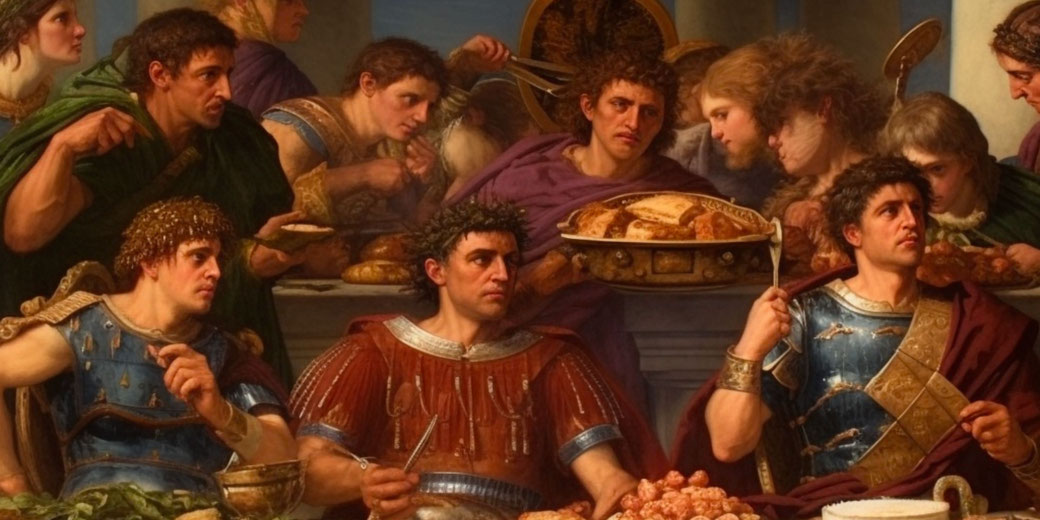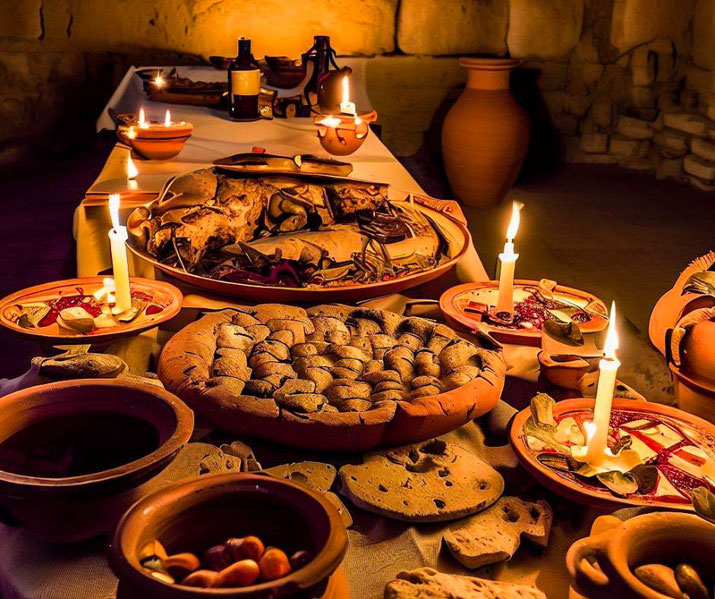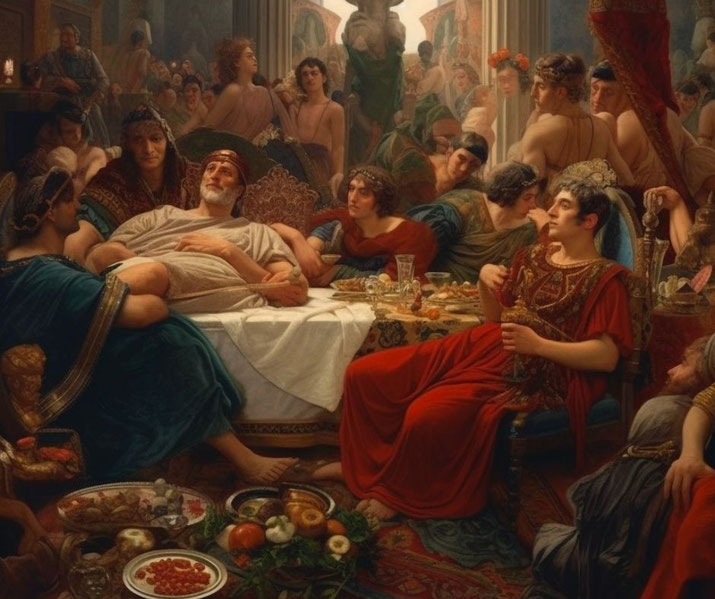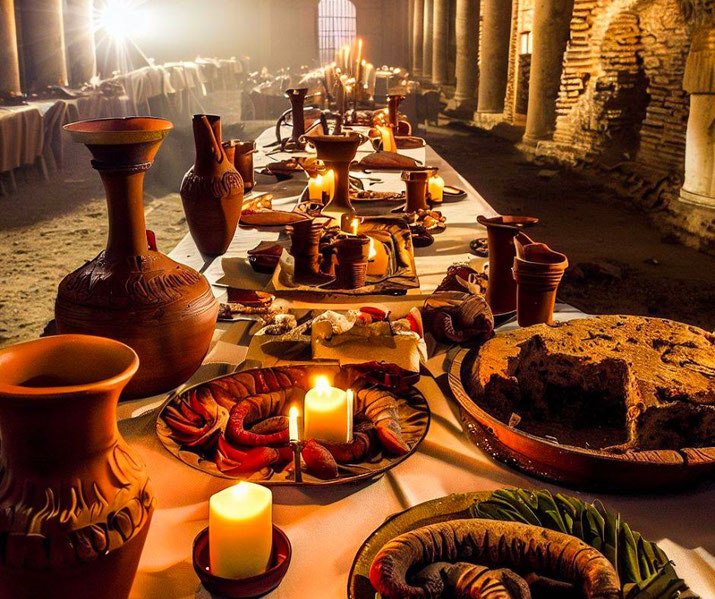How to feast in ancient Rome: The dos and don'ts when attending a Roman dinner party

Imagine yourself stepping into a luxurious Roman villa, the air filled with the rich aroma of exotic spices, succulent roasted meats, and sweet wine.
The room is buzzing with the chatter of togas-clad Romans, their laughter punctuated by the occasional strumming of a lyre and soft whispers of serving slaves.
This isn't just any meal; this is a Roman feast, the epitome of extravagance and display in ancient Rome. But this is not a place for the uninitiated or ill-prepared; one must know how to behave to truly enjoy and fit in.
So, how exactly should one conduct oneself at a Roman feast?
What rules must be followed, which foods should one prefer, and what conversation topics should be broached?
And perhaps most intriguingly, how does this dining extravaganza reflect the broader Roman society of the time?
The first things you need to know about Roman feasts
The cultural backdrop of a Roman feast is deeply rooted in the society's values, beliefs, and social structures.
These feasts were more than just meals; they were potent social tools, a means of expressing status, building alliances, and sometimes even a stage for political maneuvering.
The nature of the feast often reflected the social standing of the host, with the wealthy and powerful offering extravagant displays of their prosperity, while those of lower rank held more modest gatherings.
The divide between social classes in Roman society was starkly evident at these feasts.
The rich and powerful would recline on plush couches, dining on exotic delicacies from the far corners of the empire, while the poor, if they were invited at all, sat on stools or stood, eating simpler fare.
Yet, these feasts were also a place where the strict boundaries of Roman society could sometimes blur.
Patron-client relationships, essential to the social and political fabric of Rome, were often forged and reinforced at these feasts, with patrons providing meals for their clients as a tangible symbol of their beneficence.

Roman feasts also held deep religious significance. Many feasts were tied to specific religious festivals, known as 'feriae', which were days of rest and celebration dedicated to various deities.
The food served, the prayers offered, and even the order of courses could be dictated by religious customs.
Other feasts, particularly those in private homes, might begin with a sacrifice and a prayer, the host acting as a priest.
This religious underpinning further heightened the social importance of these feasts, transforming them from mere meals into deeply meaningful social rituals.
How to prepare yourself for dinner
The preparation for a Roman feast was a significant event in itself, steeped in its own unique customs and intricacies.
It was an opportunity for the host to demonstrate their wealth, taste, and hospitality to their guests, while also adhering to the expected societal norms of their time.
The primary responsibility of hosting the feast rested squarely on the shoulders of the domus, the head of the household.
Preparations often began days, if not weeks, in advance, with careful planning going into the guest list, menu, and entertainment.
The host would invite guests based on their social standing and relationships, often sending out invitations inscribed on wax tablets.
The guest list was typically quite selective, and receiving an invitation was considered an honor.
Personal grooming was of utmost importance for both the host and the guests. Romans placed a high value on cleanliness and personal appearance, and it was expected that all attendees would bathe and dress appropriately before attending the feast.
The dress code often varied based on the occasion and the social standing of the host, but togas were generally worn by men, and stolas, a long dress, by women.
The physical layout of the feast also required meticulous planning. The dining room, or triclinium, was typically arranged with three couches in a U-shape around a central table.
The couches were designed for guests to recline on as they ate, following the popular Roman custom.
The host would sit on the lower end of the middle couch, while the places of honor were at the upper end.
The menu was an opportunity to truly demonstrate one's wealth and connections. The more exotic and costly the ingredients, the more impressive the feast.
A typical Roman feast consisted of three courses: the gustatio (starter), the prima mensa (main course), and the secunda mensa (dessert).
Fine wine was a staple at any Roman feast, often mixed with water and spices.
Lastly, the host was expected to arrange for entertainment, which could range from musical performances to poetry recitations and even gladiatorial combat.
Such spectacles added to the overall enjoyment of the feast, providing a diversion between courses and sparking conversation among guests.
What to expect when you arrive
The structure of a Roman feast was carefully choreographed, offering a blend of food, conversation, and entertainment.
It mirrored the societal norms of the time and demonstrated the host's affluence and generosity.
The setting for these feasts was usually the triclinium, a dining room designed specifically for feasting.
The triclinium was typically furnished with three couches, called lectus, arranged in a U-shape around a central table.
The guests, usually no more than nine to ensure intimate conversation, would recline on these couches, leaning on their left arm and using their right to eat.
The arrangement of guests followed a particular order, with the place of honor being the middle couch's top position.

The feast itself generally unfolded in three stages or courses. The first course, the gustatio, was akin to our appetizers.
It consisted of light fare, often including eggs, salads, mushrooms, olives, and a kind of starter drink, usually a honey-sweetened wine called mulsum.
The prima mensa, or main course, was where the host could truly demonstrate their opulence.
It featured a variety of dishes, often including meats, fish, and poultry. For the truly extravagant, exotic dishes such as peacock or flamingo might be served.
All of these were often accompanied by rich sauces and a wide array of spices, demonstrating the Roman trade connections.
The final course, the secunda mensa, comprised sweet dishes. Fruits, nuts, and honey-based treats were common, as were foreign delicacies like dates from Egypt or apples from Spain.
This course was often paired with passum, a sweet raisin wine.
Sprinkled between these courses was entertainment. Depending on the host's wealth, this could range from a simple musical performance to full theatrical presentations or gladiatorial combat.
Additionally, intellectual discourse and philosophical discussions were commonplace, with the Romans seeing these feasts as a chance to engage in spirited conversation and debate.
The most important dining etiquette to know
Roman feasts were steeped in a complex web of etiquette, balancing convivial enjoyment with strict decorum.
Understanding these social norms was crucial to navigating the elaborate dance of a Roman feast successfully.
Perhaps the most iconic aspect of a Roman feast was the practice of reclining. Guests would rest on their left elbow on couches, leaning on cushions, and using their right hand to eat.
The tradition stemmed from the belief that only the gods stood while eating, so by reclining, Romans were honoring the gods during these feasts.
This posture also demonstrated a certain leisure class's privileges, emphasizing the social hierarchy in these gatherings.

Conversation was another important element of Roman dining etiquette. Romans highly valued intellectual discourse and wit, so guests were expected to contribute to discussions on topics such as philosophy, politics, literature, and art.
It was seen as uncouth to discuss vulgar or crude topics. Instead, guests aimed to demonstrate their eloquence, knowledge, and wit in their conversations.
The role of slaves at a Roman feast was also noteworthy. Slaves performed a variety of tasks during the feast, from serving food and wine to providing entertainment, and their presence was a symbol of the host's wealth.
However, the treatment of slaves was also seen as a reflection of the host's character.
A good host was expected to treat their slaves kindly and with respect, with instances of ill-treatment often leading to social disapproval.
While Romans enjoyed indulging in food and wine, moderation was highly respected.
Overindulgence was frowned upon and seen as a lack of self-control. Guests were expected to appreciate the fine food and wine offered, but not to gorge themselves to the point of being intoxicated or overly full.
In addition, observing the correct order of service was crucial. The host, as the highest-ranking person present, was served first, followed by the rest of the guests in order of their social status.
This process underscored the social hierarchy and respect for status within Roman society.
What range of foods should you expect to be served?
The menu at a Roman feast was a showcase of the empire's far-reaching influence, featuring a variety of exotic ingredients and dishes.
Imported foods like oysters from Britain, dates from Egypt, and olive oil from Spain were staples at a grand feast.
The Roman diet was predominantly vegetarian, with an emphasis on a variety of fruits, vegetables, and grains.
However, at feasts, meats, such as pork, lamb, poultry, and game, made a prominent appearance.
The most luxurious feasts would serve exotic meats such as peacock, flamingo, or ostrich.
The Romans had a fondness for rich sauces and seasonings, and their dishes were often flavored with herbs, vinegar, honey, and a fermented fish sauce called garum.
Bread played a crucial role in the Roman meal, and a range of bread types, from simple flatbreads to more sophisticated varieties made with refined white flour, were often served.
Desserts, usually served in the final course or secunda mensa, were primarily fruit-based, with dishes incorporating figs, dates, apples, and pears, often accompanied by honey and nuts.
The wine culture of Rome was also a vital part of the feast. Romans loved their wine, and it was considered a daily necessity rather than a luxury.
Wine was often mixed with water, a practice that made the wine safer to drink and also helped prevent overindulgence.
Wine flavors varied, with options ranging from the very sweet to the very dry, and they were often spiced or heated.
It was typically served in terracotta or silver vessels, and slaves would keep the wine flowing throughout the feast.

A feast was not just about eating and drinking, but it was also about the rituals around them.
One such ritual was the toast, usually made to the gods before the start of a feast. As a rule, the host would initiate the toast, and everyone would drink to show agreement.
This practice highlighted the religious underpinings of the feast, linking the act of dining with divine gratitude and reverence.
When to bring a gift, and who to give it to
Gift-giving and favor exchange were integral to the social fabric of a Roman feast, often serving as a tangible extension of the societal relationships and the underlying dynamics of power and obligation.
The Roman social structure was largely built on a system of patronage, where powerful individuals, the patrons, provided protection, representation, and resources to lesser individuals, their clients, who in turn offered their loyalty and services.
These relationships were often formalized and reinforced at Roman feasts.
A patron would invite their clients to their feasts as a form of gift-giving. The extravagance of the feast was a visible display of the patron's wealth and magnanimity, while the invitation itself was a recognition of the client's loyalty and worth.
In this way, the feast served as a form of social currency, reflecting the client's value and status within the patron's sphere of influence.
Clients, too, had their own obligations. They were expected to express their gratitude and loyalty to their patron, often through services or gifts of their own.
These could range from support in political ventures to personal favors. Moreover, clients were expected to behave appropriately at these feasts, showing respect to their patron and other guests, and contributing positively to the overall ambience.
While the gift-giving at these feasts was often symbolic, tangible gifts also played a part.
Small gifts, or 'bona venalia', were sometimes offered to guests as they departed, often in the form of food or small trinkets.
These gifts were another extension of the host's hospitality and a means of prolonging the memory of the feast.
Thus, the practice of gift-giving and favor exchange at Roman feasts was more than mere tradition.
It was a nuanced and complex system, an embodiment of the intricate web of social relationships that characterized Roman society.
It underscored the host's power and status while also serving to strengthen and sustain their network of support and influence.
What do you need help with?
Download ready-to-use digital learning resources
Copyright © History Skills 2014-2025.
Contact via email
With the exception of links to external sites, some historical sources and extracts from specific publications, all content on this website is copyrighted by History Skills. This content may not be copied, republished or redistributed without written permission from the website creator. Please use the Contact page to obtain relevant permission.





